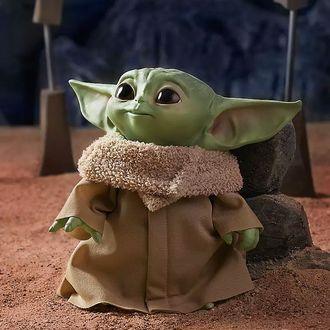
Words should have meanings. Of course language is malleable, it’s subject to changing social contexts, historical moments and technological shifts. But words with broadly accepted meanings within their sociocultural environments should not be cast aside willy-nilly and applied in patently incorrect ways. They definitely shouldn’t be applied in actively misleading ways! What I’m saying is, Disney has announced another new Baby Yoda “plush” toy, and once again, it is not a plush.
Here it is, an admittedly cute Baby Yoda toy that comes with a frog and a teacup accessory. Apparently it also talks. The description notes that it has a “plush” body and poseable arms, but also that its head is “sculpted.” This toy may be cute — it’s honestly too early to say — but just as was the case with the first Baby Yoda toy announced earlier this month, it most certainly is not a “plush.”
The primary textural experience of a plush toy or stuffed animal is of fuzzy fluffiness, generally meaning that even if the dominant covering material isn’t fur, it is some kind of cloth. It should be predominantly soft to the touch, with no hard plastic edges or sculpted pieces. In the case of a Baby Yoda toy, this would almost inevitably mean that its face would need to be slightly stylized. Rather than a direct mold of The Mandalorian’s puppet, a plush would need to be an adaptation, charming in its own way while also being representative of the original.
Toy designers should know this! I want to hug Baby Yoda! I want my children to be able to bop each other over the head with Baby Yoda and have their crying be entirely performative, not the result of actual injuries! Sure, I sound like a petulant character from a Willy Wonka novel (are those books officially Disney IP now?), but why is this so hard? Give me a legit Baby Yoda plush, or I will order a knock-off on Etsy.


